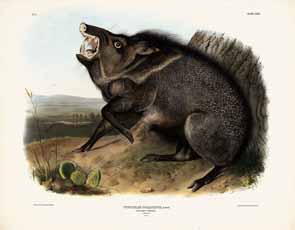United States, (1785-1851)

-
The Collard Peccary; Plate 31
- [from: “The Viviparous Quadrupeds of North America” – folio edition]
- (1844), hand colored stone lithograph
- 21.25 x 27.25 in. (53.9 x 69.2 cm.)
- Pub. Philadelphia, by J.T. Bowen 1844
-
Editor’s Note:
While peccaries look similar to pigs, their relationship is in the very distant past. Peccaries first appeared in the early Oligocene, about 32 million years ago and are classified in a separate family from pigs because of anatomical differences. Peccary are members of the Tayassuidae family while true pigs are members of the Suidae family.
People often confuse peccaries, which are found in the New World, with pigs that originated in the Old World, especially since some domestic pigs brought to North America by European settlers have escaped over the years and now run wild in many parts of the United States.
Today there are three living species of peccary, found from the southwestern United States through Central America and into South America.
- Collared Peccary (Pecari tajacu) are found in the SW United States, Mexico and S. America and are also known as the Javelina, Tayaussa or the Musk Hog
- Chaco Peccary (Catagonus wagneri) are found in S. America
- White-lipped Peccary (Tayassu pecari) are found only in Mexico
About the Artist
John James Audubon, United States, (1785-1851). Audubon was an avid hunter, painter and amateur naturalist.
After much personal and financial success with the publication of his collection of bird images – “Birds of North America”, Audubon set out to create a similar volume of North America’s four-footed live bearing mammals. This eventually became “Viviparous Quadrupeds of North America.”
